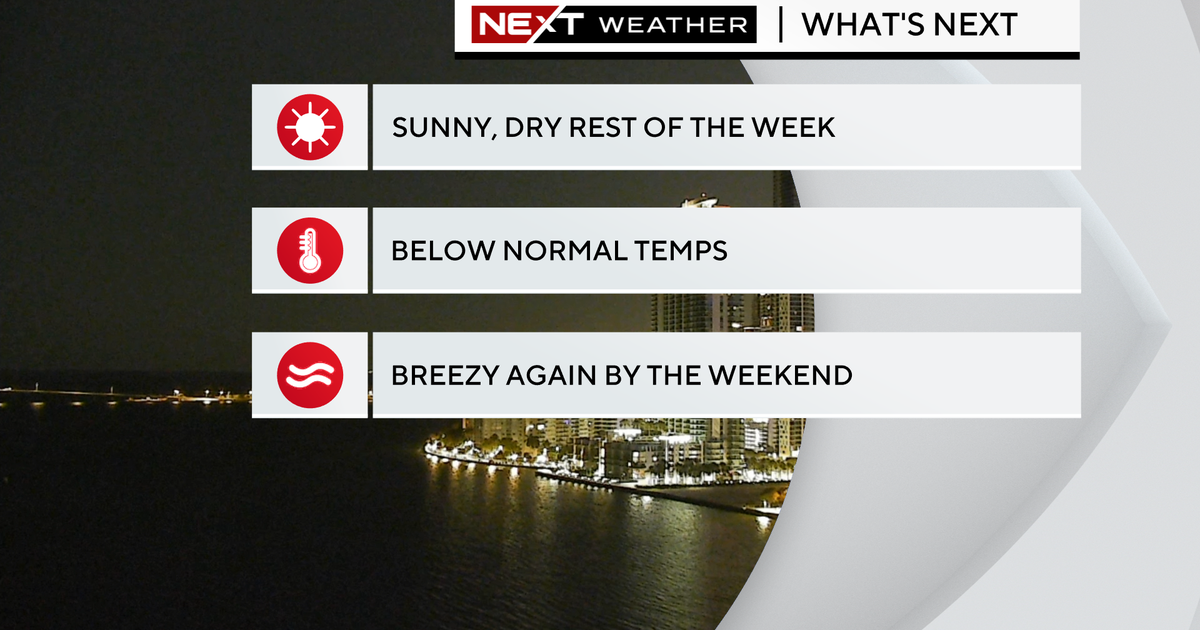Fill From Port's Tunnel Project Has Environmentalists Worried
MIAMI (CBS4)- The late-October start date for the Port of Miami tunnel dig is approaching, yet one big question about the massive project remains unresolved: Where will the giant mountains of excavated dirt and rock end up?
According to CBS4 news partner the Miami Herald, environmental regulators are considering a couple of options proposed by the tunnel contractors, who say they expect a decision in plenty of time to start digging.
But one proposal -- a city-supported plan to deposit what's expected to amount to more than 400,000 cubic yards of limestone rock and dirt from the dig on Virginia Key's North Point -- has kicked up dust among activists worried about further damage to the ecologically rich but oft-abused island.
City of Miami officials want to use the free material to build a berm to conceal the Virginia Key sewage treatment plant and to fill in an old toxic landfill next door, helping the cash-strapped city advance a plan to turn the island into a natural and recreational showcase.
But where the tunnel fill ends up could be determined by what's in it.
Most of the dirt-and-rock fill is expected to contain chemical compounds used to soften up the bay-bottom limestone for boring, as well as grease from the rotating cutter head on the massive tunnel boring machine. If testing finds high concentrations of the contaminants, the fill would be unsuitable for use on Virginia Key and could end up instead at a Medley dumping site, the tunnel contractors' proposed soil-management plan says.
Some of that contaminated fill could be mixed with clean dirt to lower the chemical concentrations sufficiently to pass environmental muster, then sold for use in construction, said Christoper Hodgkins, spokesman for Miami Access Tunnel, the project concessionaire.
"We do have people interested in buying some of this material,'' Hodgkins told the Herald.
The question of how to dispose of the limestone rock and dirt from the big tunnel dig has gained urgency as the contractors begin getting key permits from regulators for ancillary work.
State environmental regulators have approved an initial portion of the dirt-disposal proposal -- a plan to deposit 55,000 cubic yards of the fill on Virginia Key for construction of the berm on two sides of the sewage treatment plant.
But even that plan is not quite ready to go.
The material is supposed to come from excavating the tunnel entrance and exit pits on Watson Island and the port's Dodge Island, which does not require use of chemicals, the Herald reported. That fill has been certified as clean by Miami-Dade County's Department of Environmental Resources Management. But the tunnel contractor has not ruled out including in the berm material dirt from the actual tunnel dig if it comes up clean in testing.
DERM, meanwhile, has not yet signed off on the berm construction, agency spokesman Luis Espinoza said.
The tunnel project also recently received permits for another job that some environmentalists have questioned -- injecting concrete grout into sections of the bottom of Government Cut to shore up the porous limestone in preparation for boring beneath. The grout is mostly Portland cement but may also include chemical bonding agents, though the contractor says the mix is environmentally benign.
Still to come: the permit for the actual boring, which the state Department of Environmental Protection says is "under review.'' Hodgkins, the MAT spokesman, said he expects the permit to be approved by the planned start of boring.
The $1-billion tunnel project, which will provide an underground route to Dodge Island for trucks from Watson Island, is a key piece of a port modernization plan that has come under sharp scrutiny by environmental activists, including the local chapter of the Sierra Club, the Tropical Audobon Society and the Urban Environment League.
The groups are opposing a separate plan by port administrators to dredge the bay bottom on the other side of Dodge Island from the tunnel dig to accommodate a new generation of supersized cargo ships. That project would require plowing up and moving several acres of coral and risks raising the turbidity of bay waters.
The activists scored one victory when regulators agreed to keep the fill from that dredging project off Virginia Key.
Now they're raising questions about the plan to put tunnel dirt there, noting that they have fought for years to stop governments and the community from using Virginia Key as a dumping ground. The island already has an illegal landfill, which has been closed since the 1970s but still is leaching contaminants into the groundwater.
Blanca Mesa, of the Sierra Club's Virginia Key Working Group, said DERM must ensure any fill deposited on the island is clean and doesn't intrude on wetlands or other adjacent ecologically sensitive areas. She worries about local air quality and the impact on beachgoers, cyclists and runners who use the Rickenbacker Causeway and Virginia Key from a stream of trucks carrying in rock and dirt during the expected year-long duration of digging. And she notes that the areas where fill would be deposited are adjacent to the city's popular new mountain-bike trails, built atop the hills of fill dumped on the island from previous port dredging projects.
As an example of what could go wrong, Mesa points to the March mishap that forced environmental regulators to temporarily stop the transportation of fill from the Watson Island tunnel pit to Virginia Key.
A subcontractor's front-loader strayed from the approved area, pouring piles of dirt and rock on adjacent wetlands and destroying a section of mangroves planted as part of a county restoration project. Although the tunnel contractor had a county and city OK to deposit the fill in the area, a required state permit had not been applied for. That permit was finally issued last week, and the contractor was required to foot the cost of restoring the mangroves.
In the meantime, Hodgkins said, the tunnel contractors trucked some of the clean pit fill to the Medley facility, and stockpiled some on Watson and Dodge islands, the Herald reported.
Any fill that ends up on Virginia Key must meet the same DERM standards for use in residential projects, said Alice Bravo, an assistant city manager.
Because the county and city have not reached an agreement on how to seal and top off the landfill, any tunnel dirt would be stockpiled on the site until they're ready to use it. The city plans eventually to put soccer and baseball fields atop the landfill.
But having the dirt would advance the landfill fix because the city doesn't money to purchase clean fill, a lack that has delayed a solution, Bravo said. The county has earmarked $45 million for the job, with the city responsible for any costs over that.
"Having this material available will defray a substantial portion of the cost,'' Bravo said. "I don't think anyone at the city or the county wanted to miss this opportunity. But we will be looking for guidance from all the relevant environmental agencies.''
(©2011 CBS Local Media, a division of CBS Radio Inc. All rights reserved. This material may not be published, broadcast, rewritten, or redistributed. CBS4 news partner The Miami Herald contributed material for this report)



